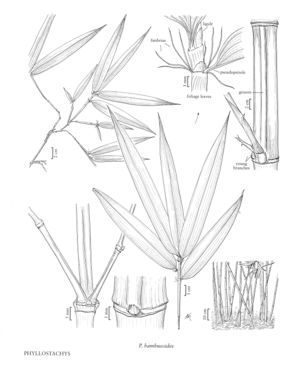Phyllostachys bambusoides
Culms to 22 m tall and 15 cm thick, erect or leaning towards the light, base sinuous in some cultivars; internodes glabrous, usually green, in cultivars golden yellow, or with yellow and green stripes, lustrous; nodal ridges usually prominent (scarcely discernible in Crookstem forms); sheath scars thin, not strongly flared, glabrous. Culm leaves: sheaths glabrous or pubescent, greenish to ruddy-buff, more or less densely dark-brown-spotted; auricles absent from the basal sheaths, narrow to broadly ovate or falcate on the upper sheaths; fimbriae greenish, crinkled; ligules rounded and ciliolate to truncate and ciliate with coarse hairs; blades short, lanceolate, reflexed and crinkled on the lower leaves, those above longer and recurved, green or variously striped. Foliage leaves: auricles and fimbriae usually well developed; ligules well developed; blades to 20 cm long and 3.2 cm wide, usually puberulent to subglabrous. 2n = 48.
Distribution
Md., La., Calif., N.C., Ala., Tenn., S.C.
Discussion
Phyllostachys bambusoides, a widely cultivated species, is hardy to -17°C. Several cultivars are available, differing in the color of their culms and leaves.
Selected References
None.
Lower Taxa
"decumbent" is not a number.
